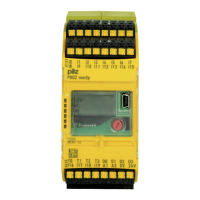
Do you have a question about the Pilz PNOZ mm0p and is the answer not in the manual?
| Brand | Pilz |
|---|---|
| Model | PNOZ mm0p |
| Category | Controller |
| Language | English |
This documentation is valid for the product PNOZ mm0p. It is valid until new documentation is published.
This documentation is intended for instruction and should be retained for future reference.
This chapter provides information on the product's most important features.
Information that is particularly important is identified as follows: DANGER!, WARNING!, CAUTION!, NOTICE, INFORMATION.
Information about the product's unit structure, including range, features, and chip card.
Identifies the base unit PNOZ mm0p within the PNOZmulti configurable control system.
Details the features of the PNOZ mm0p, including outputs, inputs, and LEDs.
Explains the necessity and availability of chip cards for product operation.
Illustrates the front view of the PNOZ mm0p unit and provides a key to its connectors and LEDs.
Defines the correct application of the PNOZmulti system and specifies improper uses.
Outlines system requirements and refers to external documents for product version details.
Covers regulations for qualified personnel, warranty, liability, and disposal of the product.
Defines a competent person and the company's responsibility for employing qualified personnel.
Details conditions that invalidate warranty and liability claims for the product.
Provides guidance on complying with mission time and local regulations for disposal.
Highlights essential safety requirements for the unit's safe operation, including protection and modifications.
Explains the device properties, including integrated protection mechanisms, operation, and block diagram.
Describes the safety criteria the relay conforms to, including redundancy and self-monitoring.
Explains how the system's inputs and outputs function based on the configured circuit and chip card.
Presents a block diagram illustrating the unit's internal connections and functionality.
Details how status and error messages are saved and can be accessed via the display or configurator.
Provides guidelines for installing the unit in a control cabinet, including protection type and mounting.
Shows the physical dimensions of the unit, including a diagram with measurements.
Specifies the necessary mounting distances around the unit for proper heat dissipation and operation.
Provides essential guidelines for wiring the PNOZmulti system, including wire types, protection, and connection rules.
Details steps for preparing the unit for operation, including function tests and chip card usage.
Emphasizes the importance of checking safety devices after chip card exchange or project download.
Provides instructions and notices regarding the proper handling and insertion of the chip card.
Outlines the procedure for commissioning the safety system, including wiring and power connection.
Details the process of loading a project from a chip card to the base unit.
Explains how to load a project to the base unit using a computer via the USB port.
Provides information on supply voltage connections and connection examples for input circuits.
Shows connection examples for reset circuits and semiconductor outputs, including advanced fault detection.
Provides connection examples for feedback loops in redundant output configurations.
Illustrates a detailed connection example for a dual-channel E-STOP and safety gate wiring with feedback loop.
Explains the function and operation of the rotary knob for menu settings and navigation.
Describes how the rotary knob is used to make menu settings on the unit's display.
Details the steps for pulling out and retracting the rotary knob from the unit.
Explains how to rotate and press the rotary knob to select menu levels and confirm settings.
Details how the PNOZmulti control system indicates its operational status and displays messages.
Describes the display elements, including status indicators for LEDs and device diagnostics.
Provides a legend for interpreting LED status indicators (ON, flashes, OFF).
Lists error messages and their corresponding LED status combinations for device diagnostics.
Explains the LC display's four lines for showing information, running status, errors, project info, and device info.
Shows the error stack entries on the LC display.
Details the information shown for each error stack entry (sequential number, EC, EI, EN, PA).
Allows selection of the interface or displays interface status on expandable base units.
Provides an option to bring the device to a STOP condition.
Allows deletion of the project from the base unit's memory.
Provides an option to exit the current menu.
Illustrates the schematic representation of menu functions and how to navigate between menu levels.
Explains how to show error messages that do not lead to a safe condition and how to reset the unit.
Describes how to read the error stack on the LC display or via the PNOZmulti Configurator.
Provides detailed electrical data, input/output specifications, status display, and timing information for the unit.
Details technical specifications including environmental data, EMC compliance, vibration, and mechanical data.
Lists mechanical data for conductors and terminals, dimensions, weight, and safety characteristic data.
Presents a graph showing the maximum capacitive load versus load current for semiconductor outputs.
Displays a graph illustrating the maximum permitted total current for semiconductor outputs.
Lists order references for the base unit, accessories like terminals, and relevant cables.